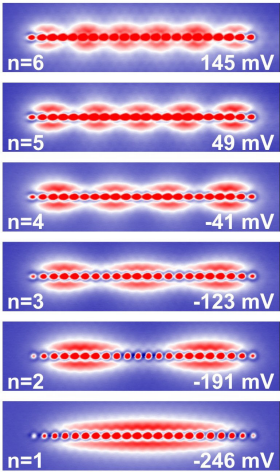NRL reports a breakthrough in 'quantum dots'
Researchers' ability to create the dots with single-atom precision holds promise for fields from photonic to quantum computing.
Researchers from the Naval Research Lab, Germany and Japan have reported a breakthrough in quantum research, saying they were able to create what are called quantum dots of identical sizes, something that could have an impact in a variety of fields, including quantum computing.

The team used a used a scanning tunneling microscope to eliminate the variations in quantum dots that had plagued research into the field, NRL said in a release. The findings of the team, which included researchers from PDI (Paul-Drude-Institut für Festkörperelektronik) in Germany, and NTT Basic Research Laboratories in Japan, were published in the July issue of Nature Nanotechnology.
Quantum dots are nanocrystals small enough to display quantum mechanical properties. But they’re made up in some cases of hundreds of thousands of atoms, which leads to variations in their size, shape and arrangement, NRL said. Using the scanning tunneling microscope, researchers were able to build their dots atom by atom, in a pre-determined shape, and then repeat the process in chains of up to 25 atoms. The image above, from PDI, shows a chain of 22 atoms.
The researchers said the results could lead to quantum architectures devoid of variations, which would have implications for technologies ranging from nanophotonics to quantum computing.
Quantum computing is generally viewed as the next leap forward for information processing, with the potential to greatly outstrip even the fastest supercomputers for some types of problems, from chemistry to code-breaking.
Quantum dots have been proposed as one way to make quibits, or quantum bits, which instead of representing a one or a zero like the bits in traditional computing, exist in both states at the same time. The basic idea behind quantum computing is that, rather than going through a problem linearly, one thing at a time, as in traditional binary computing, a quantum machine could attack all elements of a problem at once and solve it more quickly. For example, a supercomputer using a brute force attack would take a billion billion years to break 128-bit encryption, as explained by EE Times. A quantum computer, theoretically, could solve the problem in minutes.
One key to how well a quantum computer can work is the number of quibits it has entangled together. The research team’s ability to create what it calls atomically precise quantum dots could make using them as quibits more viable.
The technology’s potential has gotten the attention of government and industry. Because one of its potential uses is code-breaking, people have speculated for years that the National Security Agency was building such a computer, and documents leaked by Edward Snowden appear to confirm that.
But quantum computing has other potential uses as well. The Defense Advanced Research Projects Agency is funding university research into quantum computing. NASA is interested in its potential for artificial intelligence, and has formed the Quantum Artificial Intelligence Lab with Google and the Universities Space Research Association, working with D-Wave Systems’ 512-quibit D-Wave Two quantum computer. Lockheed Martin also owns a D-Wave Two (price tag: $15 million). And Microsoft is investing in the technology.
Although quantum computing exists, it’s still just taking baby steps. A recent test of the D-Wave Two by the Swiss Federal Institute of Technology, in fact, found that the quantum machine was no faster than traditional computing, at least for certain computations. D-Wave and Google disputed the validity of the test, however, and said their own tests have gotten positive results.
At any rate, it’s clear that quantum computing has a long way to go. The NRL team’s breakthrough on quantum dots just might help move things along.